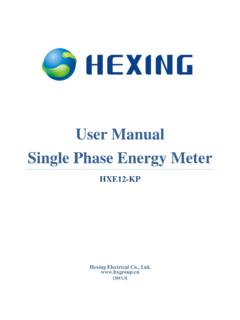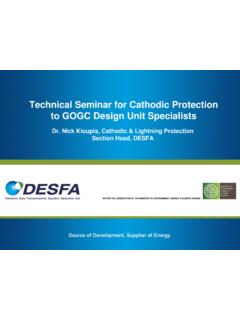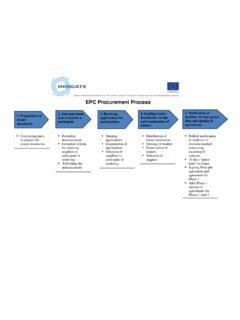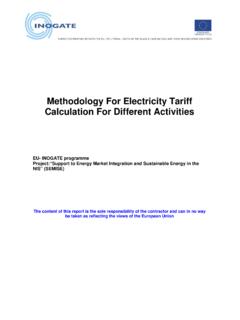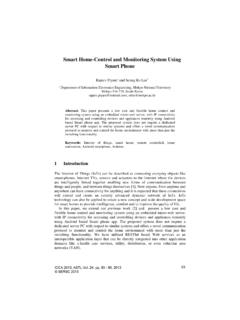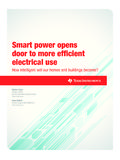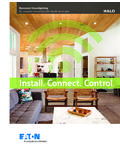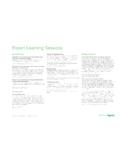Transcription of Smart/Intelligent Buildings - INOGATE
1 Smart/Intelligent Buildings Yerevan State University of Architecture and Construction Slides prepared by: Albin Zsebik, PhD, CEM INOGATE Programme New ITS Project, Ad Hoc Expert Facility (AHEF) Senior Task Coordinator AM-55 Larry Good, CEM, CEA Typical building Cost over a 40 Year Life Cycle Source: David Katz There are many interpretations of intelligent design: The main interpretations mostly consider the crucial role of technology without sufficient consideration of social, cultural and user interactions. Other similar studies define intelligent Buildings as automated Buildings with flexibility, cost-efficiency and integrated technical performances. However, a few studies criticize previous interpretations while arguing that intelligent Buildings must be responsive to the user s actual needs. What is a smart / intelligent building ? - 1. intelligent building accentuates a multi-disciplinary effort to integrate and optimize the building structures, systems, services and management in order to create a productive, cost effective and environmentally approved environment for the occupants.
2 Despite the previous interpretations of the concept of intelligent building , recent studies proclaim that it must create a successful combination between the environment and the occupants. What is a smart / intelligent building ? - 2. smart building refer to built environments such as apartments, offices, museums, hospitals, schools, malls, university campuses, and outdoor areas that are enabled for co-operation of smart objects and systems, and for ubiquitous interaction with frequent and sporadic visitors. Prime business scenarios include smart retail environments and public areas providing better service to customers and citizens, and home and office environments making living and working more comfortable and efficient. What is a smart / intelligent building ? - 3. The Smart/Intelligent building involves the use of integrated technological building systems, communications and controls to create a building and its infrastructure which provides the owner, operator and occupant with an environment which is flexible, effective, comfortable and secure.
3 What is a smart / intelligent building ? - 4. smart Buildings : definition and services A smart building is equipped with a communications network, linking sensors, domestic appliances, and other electronic and electric devices, that can be remotely monitored, accessed or controlled, and which provide services that respond to the needs of its inhabitants resp. users. In other MONITORING Breakdown, Plant Tuning, Conditioned Monitoring, Car Park Utilisation FIRE Functionality checks, Detector service, Fire, Life Safety ACCESS - Doors Buildings Occupancy Feed Forward ENERGY - Utility Monitoring (Elec/Water/Gas/Oil) Tenant building Air/ Water, Heat, Lighting Back-up Generation HVAC - Air-Handling Unit, Boilers, Pumps, Fans, Energy Control, Variable Air Volume, Air Quality LIFTS Breakdown, Mainte-nance, Traffic Performance SECURITY - Doors PIR Integration LIGHTING - Schedules Occupancy Sensing W G E COMMUNICATIONS Voice/Video/Data building Technologies Competencies, tasks Controls and Equipment Market Engineering Services Strategic Analysis home automation HVAC Controls and Equipment Lighting Controls and Equipment Fire and Life Safety building automation Controls Performance Contracting Integrated Facilities Management Remote Monitoring Services BAS Installation and Maintenance Energy Management Services Web Accessible Control Systems Integration of BAS with building Security Systems Indoor Air Quality: Issues and Strategies Integration of Security and Fire with BAS: Putting More Information to Effective Use What is Integration?
4 Systems can only be considered Integrated if they were designed to seamlessly share, versus duplicate, system resources Types of integration: Proprietary integration Front-end integration Open integration Integration: System fundamentals Integration of Security and Fire with BAS: Putting More Information to Effective Use What is Interfacing? Where two previously stand-alone systems are interfaced to each other via software and two-way communications to share data and commands Types of integration: Custom interfaces Bundled custom interfaces Front-end interfaces Open interfaces Interfacing: System fundamentals Integration of Security and Fire with BAS: Putting More Information to Effective Use Technological evolution of BAS Pneumatic Transmission Electric Controls Electronic Controls Mini Computers Personal Computers Direct Digital Controls BACnet/Lon Revolution Internet/Intranet Growing Convergence of BAS and IT Wireless Interfaces and Email Alarms IT Standardizing Information Presentation Models BAS and IT converging Growing need to interconnect building facilities spread over different geographical locations for remote monitoring/analysis and control Use of BAS data for other organizational needs such as facility management Increasing machine-to-machine communication Growing Convergence Increasing need for interconnecting facilities and accessing real-time data over the internet Convergence of Enterprise network and the building automation network for data communication and sharing facility wide data for
5 BAS as well as other organizational needs Time to integrate network and building security - 1. Fastest growing markets are physical security, biometrics and radio frequency identification (RFID) in the automatic identification sector Businesses must realize the importance of integrating physical and digital security in the workplace by accepting that security is a single issue rather than breaking it down in terms of digital and physical security Integration of Security and Fire with BAS: Putting More Information to Effective Use Facilities access makes the security of IT systems vulnerable. As per industry feedback, approximately 70 percent of data theft from a company is physical theft The need to cut costs is another driving factor for this convergence. Integration of the budgets for physical and IT security can deliver substantial efficiencies The efficiencies become even more compelling when a common data repository is used for all identity related information Time to integrate network and building security - 2.
6 Integration of Security and Fire with BAS: Putting More Information to Effective Use Digital age is ushering in a convergence of voice, data and video. How the information is stored and retrieved is becoming more important than Where it is stored. Security providers can use this information to provide additional services: Supervision Email notification Browser interfaces Audio/video Up/download common configuration databases on the network Moving towards IP centric platform Integration of Security and Fire with BAS: Putting More Information to Effective Use Fire is a regulated, code driven business. Interference of any other system with fire is being controlled by the governing agencies like NFPA to make it fail safe as versus fail secure Interfacing of fire alarm systems with BAS and other building safety systems is on the rise Audibility and intelligibility issues are enhancing the protection being provided by voice evacuation systems Fire alarm panels: Are we there yet?
7 1. Integration of Security and Fire with BAS: Putting More Information to Effective Use Distributed intelligence with peer to peer network is being preferred as it offers better survivability for the systems In a trend towards open and multiple protocols, end-users are asking for program and access codes to integrate two panels of different makes Inherent barriers such as regulations, codes and mandates, and embedded industry practices inhibit the introduction of new technologies Integration of Security and Fire with BAS: Putting More Information to Effective Use Fire alarm panels: Are we there yet? 2. Fire are passive systems with no user interaction required while security systems are highly interactive. This generates inherent conflicts in integration. The fire equipment manufacturers prefer a very clear demarcation between the fire and the other building systems. Although the fire industry is open to interface their systems at the island level yet it is not embracing the concept because flawed integration may compromise the reliability of fire systems.
8 Integration of Security and Fire with BAS: Putting More Information to Effective Use Fire alarm panels: Are we there yet? 3. Fire and Life Safety Industry It is a proprietary and code driven environment building Security Industry There are no real dominant players in the market in terms of a vertically integrated total solution This industry seems to be most enthusiastic about integration HVAC & Lighting Industry Integration Different perspectives Industry Perspective End-user Perspective Indifferent End-users Lack of Knowledge and Limited Awareness About Benefits Aware but Uneducated End-users Perceptions of High Costs and Technological Complexities Aware & Educated End-users Very Specific about Security Needs, no Interference from other building Services Integration of Security and Fire with BAS: Putting More Information to Effective Use Accessibility to enormous information for diverse applications across facilities promising growth for integration Quick return on investments attributed to shared resources like wiring, common databases, etc.
9 , driving demands Lack of specifications for integrated systems challenges consulting engineers to recommend integrated systems Lack of standardization of data to be exchanged slowing growth of the market Apprehensions of IT personnel about level of network security discouraging integration potential Key trends and challenges Integration Issues and Concerns Integration of Security and Fire with BAS: Putting More Information to Effective Use building use classifications for building intelligence quotient (BIQ) ranking Multi-family residential Commercial office Corporate Medical Health care Light manufacturing Warehouse Retail Sustainable environmental solutions Resource management consulting Energy and environmental expertise building automation and systems Utility system planner Power broker Financial and risk analysis Multi-attribute and decision analysis intelligent building life cycle building automation Systems 5-7 years Telecommunications 3-5 years Office automation 1-2-3 years LAN Video Imaging building Structure Life Cycle = 40+ years Lighting Power Security HVAC Lifestyle support Types of smart building services Source: Nazmiye Safety Energy consumption & management Energy efficiency Security Assisted living Convenience & comfort Communications Entertainment e-health Four key aspects characterize a smart home 1.
10 A communications network through which different devices talk to each other controls to manage the system that collect information features (Example: intelligent heating systems that adjust automatically to external temperature), which respond to information from sensors or user instructions [25] as well as to the system provider (Example: Remote control of appliances) Key requirement for smart Buildings Key infrastructure required for the smart home , including new and existing homes: The smart home network Interoperability Reliability Security Two principal elements of the smart home network 1. A physical connection linking the components - a wired connection or a radio signal (as in the case with wireless ) 2. A shared language by which the various components can communicate with one another and exchange information through a communications protocol Interoperability The successful smart building must evolve and adapt to changing preferences, demands and needs.

